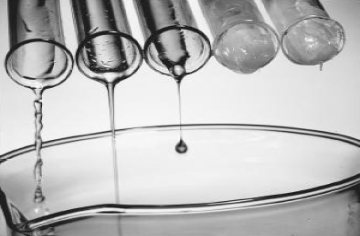Lubricant Analysis
Viscosity Measurement

The viscometric technique most used in the oil industry is probably the measure of kinematic viscosity using capillary glass viscometers. Kinematic viscosity is part of the viscosity classification system for automotive engine oils, gear oils and industrial lubricants....
Viscosity measurement is a relatively simple procedure within a laboratory. It basically consists of inserting the lubricant in a capillary tube, previously calibrated, and measuring the time it takes to fill the bulb between two menisci. Multiply the time measured by the tube constant and have the viscosity at the desired temperature.
The ASTM D-445 method is the most reported by laboratories. It describes all the conditions for the test to be performed, repeatability, reproducibility and some capillary tubes for opaque and transparent liquids that can be used. The standard is also clear with regard to the selection of capillary tubes that can be used to determine the lubricant viscosity. The method also indicates that it is possible to use any capillary tube available on the market, as long as the test conditions and the determined precision are respected. This explains the variety of tubes and equipment available on the market.
The most used capillary tubes for manual measurement are the Cannon-Fenske type for transparent and opaque liquids. They are widely used in R&D laboratories.
Semi-automatic equipment does not always use the same tubes described by the standard. Some manufacturers develop their own models of capillary tubes to be used in their equipment. In this equipment, the technician adds the sample to the tube and triggers the system, which measures the viscosity, cleaning and drying the tube, leaving it ready for the next analysis. This equipment is widely used in service provision laboratories. Automatic equipment differs from semiautomatic ones with regard to sample handling. In automatics, the sample is added to a container, which is placed in a “carousel” and the system takes care of the rest. These devices are more expensive, and therefore less used. Houillon type viscometers (ASTM D-7279), give good results with shorter analysis times.
The three types of equipment are very good if well maintained. I have already visited some laboratories and seen the capillary tubes very dirty in deplorable conditions. The tubes were so impregnated with dirt that it was not possible to see the oil inside them. Maintenance is important and has to be done periodically. The items that must be included in maintenance are, at a minimum:
- Changing the bath oil if it is cloudy or dirty;
If the oil is cloudy, the oil can be heated to 100 ° C to evaporate the moisture present in the oil. If it is still cloudy, it is best to make the switch. - Internal cleaning of tubes;
The internal cleaning of the tube can be done with sulfochromic solution whenever the tubes are left with the walls impregnated with dirt. - Verification of temperature control;
Temperature control is very important because it directly affects the measurement of viscosity. Use a calibrated external thermometer and check the temperature at predetermined times. - Verification of capillary tube constant;
Daily, measure the viscosity of a reference oil and, when the results are outside the control limits (assuming the CEP is implemented in the laboratory), clean the tube and recalibrate. - Capillary tube calibration
Calibration should be done whenever:- Pre-determined by the laboratory management.
- Whenever the CEP indicates the need for recalibration
- Whenever the reference oil is outside the limits of the control chart.
Some important aspects of viscosity measurement
The viscosity of a lubricant is influenced by contaminants inside and outside the system. The increase in viscosity may indicate oxidation of the oil, presence of soot, contamination by other foreign particles, degradation of additives or evaporation of the light components of the base oil. The decrease in viscosity may indicate fuel dilution, thermal or shear degradation of high viscosity lubricant components, such as viscosity index improvers, or mixing with a lower viscosity lubricant.
Let your comment here
All fields must be filled